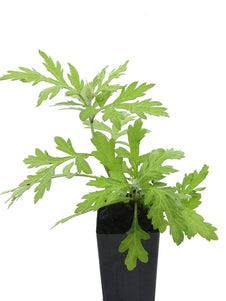
Mugwort - Tree
Mugwort - Tree

- Low stock - 19 items left
- Inventory on the way

Usually available: All year
Life cycle: Perennial
Height: 1 - 2m
Position: Sun / part shade
Soil preference: Well drained
This is how we pack and send your Herb Plants to all states except TAS & WA
You will receive
- 1 Mugwort - Tree Herb Plant in a 50 X 75mm tube - General growing instructions
All of our Herb Plants are grown organically with certified organic potting mixes and fertilizers
Botanical Name: Artemisia verlotiorum
Mugwort Tree is a perennial growing to 1 - 2 meters high and 1.5 meters wide. It has several tall, green stems that are generally unbranched, but as the plant ages it may have several obvious stems. In some areas it may die back to the rootstock over winter and be considered semi- deciduous. When Mugwort Tree is not flowering it may be ‘chrysanthemum like’ in appearance.
The dull green leaves are deeply lobed and have a white underside. The lanceolate leaves are 5-10cm by 3-8cm wide and are lighter than the stem colour. The leaves have a strong aroma that is said to be more pleasant than Artemisia vulgaris, which is known as Common Mugwort or Common Wormwood, depending on the global region. The reddish coloured flowers are very small and appear in late summer and autumn, held on elongated, branching terminal spikes. They attract bees and insects, but seed is not produced.
Mugwort Tree may also be called Chinese Mugwort, due to its Asian origins. It prefers to grow on sandy riverbanks and is one of several species of Artemisia native to East Asia, including North Japan and China. It is naturalised in Great Britain and is widespread in Europe, North Africa, Central and East Asia. In Belgium and Great Britain, for example, it has been commonly recorded growing in wastelands. It may also be called ‘Verlot’s Mugwort’ because it was named for Jean Babtiste Verlot who first distinguished this plant from A. vulgaris, and also for his brother Pierre Bernard Verlot. Be careful not to confuse this plant with the smaller growing shrub called Tree Wormwood or Giant Mugwort (A. arborescens) and to distinguish it from A. vulgaris.
Growing Conditions
Mugwort Tree is useful as a hedge or windbreak due to both its size and fast growth rate. In some areas of the world it is considered a weed due to the spreading root habit. Artemisia verlotiorum is adaptable to most soils and conditions. It is widely naturalised in Eastern Australia and is considered a weed in some areas, because the underground rhizomes compete with other plants for space and moisture. The plant reproduces mainly by stolons and is capable of forming thick groups of plants. It is considered both drought and frost tender, reflecting its natural habitat near water.
Medicinal Uses
The leaves are said to be useful for worming animals.
A Note on the Wormwoods
Wormwood is the common name for many plants in the Artemisia genus, which has from 200-400 named species. Each species quite likely also has many synonyms. In many cases, the name wormwood is used interchangeably with mugwort, although they are two separate species. When looking for a specific plant, be sure to check for the scientific name so you can have some certainty.
The wormwoods are hardy, woody perennials that remain evergreen during warm winters. In colder regions they generally return in spring when the seasons change. Most are very hardy, having originated in arid or semi-arid regions with poor soils and limited moisture. Some of the plants in this genus do have greenish foliage, but many have silver - grey - white foliage and these are highly prized ornamental plants. They usually have insignificant flowers and many hybrids do not produce viable seed. Most are best propagated by cuttings.
The name Artemisia is from Ancient Greek used in Hellenistic cultures, where the Goddess Artemis was the goddess of the hunt, protector of the forest and children. Artemis was also a protector of women, particularly those experiencing childbirth. The goddess Artemis was also said to be the goddess of the herbalist. The term wormwood is from the Middle English wormwode or wermode, which was attributed to the plants antihelminthic attributes in helping to expel worms from the body.
Plants such as wormwood, mugwort and sagebrush are all known for their high essential oil content. All are well known, with a long tradition in magic and folklore, where they are used for both their natural and supernatural properties. In old times, hanging Artemisia on the door was a sign that a midwife or herbalist was in residence.
Further information on other wormwoods may be found at Roman Wormwood, Wormwood ‘Powis Castle’ and Camphor Wormwood.
All information provided on this website is for informational purposes only. Please seek professional advice before commencing any treatment.




